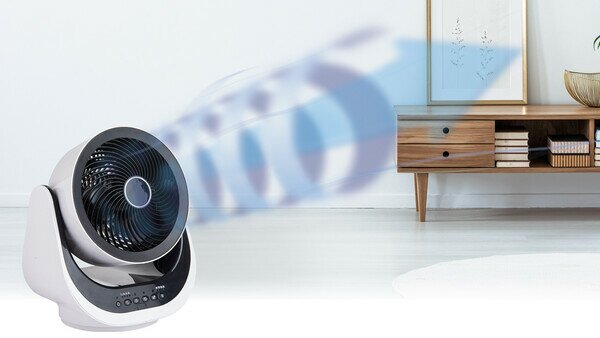With the onset of warm weather, the season of high humidity is approaching. Many households will shop around for air circulator fans (or convection fans) to speed up indoor air circulation to bring relief from the humidity. Consumer Council tests of 14 models of air circulators found that only 4 models fully complied with all the safety test requirements, and there was variable performance among the models in terms of airflow rate and energy efficiency by some 60% and 70% respectively.
The 14 air circulator fan models had fan blade diameters from 15cm to 22.3cm and were priced from $480 to $1,698. The tests focused on 6 aspects of performance: airflow rate, safety, energy efficiency, noise, durability, and ease of use. The results indicated that the overall performance of the models was fairly even, with an overall rating between 3.5 and 4.5 points.
The safety tests were conducted with reference to the International Standard IEC 60335-2-80. Only 4 of the 14 models passed all the safety test items. 7 models failed the safety tests on electrical insulation and protection against electric shock, construction, mechanical safety, and temperature rise etc. Consumers should carefully compare the performance of various models before purchasing. In the fire-resistance tests, some plastic materials in 2 of the models did not pass the needle-flame test, since the flame produced was not self-extinguished within 30 seconds, thus failing to comply with the requirements of the standard.
The mechanical safety of 2 models failed to meet the IEC standard. In one model, a gap at the rear guard could be accessed by a test probe simulating an adult finger, allowing it to come in contact with the fan blades. In the other model, during vertical auto-oscillation, the test probe simulating a child’s finger could be caught in the gap between the fan head and base. Improvement is clearly needed in the safety design of these models. When using air circulators, consumers should ensure a safe distance from the fan and that it is placed beyond the reach of children.
In general, the bigger the diameter of the fan blades, the stronger the airflow rate. In the models with a bigger fan blade diameter (19cm to 22.3cm), the airflow rate was between 10.4 and 19.9 cubic meters/minute, a variation of some 48%. Models with smaller diameter fan blades (15cm to 18.2cm) had airflow rates ranging from 7.5 to 12.4 cubic meters/minute, a difference of 40%. The measured difference between the 2 model groups could reach up to a maximum of 62%.
On energy efficiency, for every watt of energy consumed, the models produced airflow rates varying from 0.2 to 0.7 cubic meters/minute, a difference in energy efficiency of 67%. One of the models, with a relatively low airflow rate (8.6 cubic meters/minute) and the most energy efficient, was found to have the least power input (12 watts); when the model was run for 10 hours, the energy consumption was only about 0.1 unit of electricity. But for another model with a similar airflow rate (8.5 cubic meters/minute), the power input was up to 34.7 watts; operating the model for 10 hours consumed some 0.3 electricity unit, or 3 times the former. Therefore, even air circulators with a similar airflow rate, consumers should compare the energy consumption to optimize the energy efficient and to support sustainable consumption. According to the test result, if air circulator fans run for 10 hours per day for 160 days, energy consumption will be varied up to 62 electricity unit, about $74 if based on the rate of $1.2 per electricity unit.
The tests also measured the noise level of the models. The results showed that 1 model that was not fitted with the auto-oscillation function had the quietest performance, scoring 4.5 points. 5 models with a higher noise level scored 3 points; 4 of them belonged to the group with bigger fan blades. However, all samples are relatively quiet at their lowest wind speed, and the model with the highest noise level was only about 49 decibels. Consumers are advised to set the fan speed lower so as to reduce noise when sleeping.
Regarding durability, each of the 14 models was run for 1,600 hours (assuming 10 hours per day for 160 days). One model began to show an irregular auto-oscillation motion after just 420 hours, though it completed the test. Consumers who need to keep their air circulators on for prolonged periods should take into account appliance durability and operational performance.
When purchasing and using air circulator fans, consumers are suggested to heed the following suggestions:
- Compare products for energy efficiency and airflow performance; choose those with a good airflow rate and low energy consumption to enhance indoor air circulation;
- Before moving or cleaning the air circulator fan, or storing it for a long period, disconnect the plug to completely cut off electricity supply, and make sure children do not switch on the appliance without adult supervision;
- Make sure children do not accidentally touch the fan guard or put their fingers in the gap to minimize the risk of accidents;
- An air circulator fan can be used along with an air conditioner to disperse the cool air to every corner of the room. Its higher wind speed will increase the cooling effect and reduce electricity use since the air conditioner can be run at a higher temperature setting;
- Set the timer before going to sleep so that the appliance will shut down automatically; remember to turn it off before leaving home or when not using the air circulator fan.
The Consumer Council reserves all its right (including copyright) in respect of CHOICE magazine and Online CHOICE.



